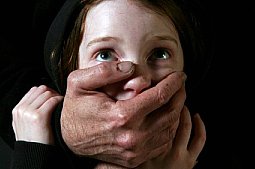Stranger Danger
vs
Stranger Safety
FAQ

The usual Stranger Danger warnings for kids aren't always effective because kids aren't always sure what or who a stranger is. And once a child learns a stranger’s name, he’s no longer seems like a stranger. Further, even adults often don’t recognize a friendly predator..
In addition, good strangers far outnumber bad strangers – and are very willing to help any child who’s lost or afraid. Most people will risk their necks trying to save your child – IF they realize the child is in danger. Make sure your child knows to ask strangers for help in an emergency by repeatedly yelling "NO!" or "Help! Police!" Stranger Safety can save a child.
[Btw, most abductors and molesters are acquaintances of the child. See Caretakers Above Suspicion on child safety - molesters and "Free Play in a Safe Range" on Free-Range Kids. Especially see "Stranger Danger Escape Lessons" on child safety - kidnapping.]
CHILD SAFETY TIPS for STRANGER DANGER
• Know your full name, phone number and address.
• Never be alone off your property. Stay with friends – even when going to public lavatories.
• Always get your parent’s OK before going anywhere – and phone your parent often.
• Walk only on routes to school and elsewhere that your parent has
scouted out with you and pointed out safe places along the way. And never walk through parking lots or take other shortcuts.
• No headphones or hand-held games to distract you from what’s around.
• If an adult asks for help, tell him to "Go ask an adult.”
• If an adult in a car or truck asks for help, just run the other way – toward other people.
• Cute animals and candy are just two tricks used by bad people to get near you.
• Always get your parent’s OK before accepting money or a gift.
• If you see someone doing something wrong, go the other direction.
• Do not have your name printed on anything visible to strangers.
• Give up your valuables if you’re robbed by another kid – never fight back.
• Never get money for any school or club project unless your parent is with you.
• Don’t trust anyone who tries to get you to break your parent’s rules.
• Tell your parent about places or people that make you feel unsafe.
• Have a secret code word for emergencies. If you phone your parent
while you’re with someone who scares you, you can say the code word to
secretly let your parent know that you need help.
IF YOU FEEL SCARED
• If you think you’re being followed by someone, start blowing your whistle (or pull the pin on your noisemaker) while running to a store or a home where you know someone is at home (stranger safety). Run to anywhere there are people to help you – and be loud about it. (Instead of hanging a whistle around his/her neck on a cord that can be used to strangle, use a beaded-metal chain that breaks too easily for strangling. Or wear a whistle on a wrist bracelet.)
• Trust your feelings. If you feel scared, just run away to a safe place. Yell “NO!” then RUN and TELL an adult.
• If someone grabs for you, thrash, fight, bite, and yell "NO!" over and over, shed a jacket or backpack that is grabbed, drop anything you're carrying, run to a place with people, and call the police. YELL! RUN! TELL! A kidnapper is afraid of anyone seeing him and may simply flee alone.
• What if he has a weapon? Ignore it and run! Weapons are rarely used to threaten a child, and almost never used to harm a child at the kidnapping scene. A kidnapper does not want to attract attention. Besides, if he’s willing to harm a child there, he’s willing to do even worse harm at a secluded location.
IF YOU'RE BEING CHASED
Keep yelling "NO!" while choosing any option:
• Pull the pin on your personal noisemaker alarm.
• Hug a tree, pole, or any solid object, or even a bicycle.
• Run in circles around an object such as a parked car.
• Get under a car (belly up) and hold onto the underside so he can’t
drag you out. If he crawls under there after you, get out on the other
side, and run.
• Pull a fire alarm.
• See Child Safety Kidnapping Escape for physical self-defense and much more.
SET YOUR BOUNDARIES

Don't turn your back on someone you don’t trust – keep watching him. If he begins to approach you, raise one hand in a “STOP!” gesture, grab your whistle (or noisemaker alarm) with your other hand, and fiercely tell him to "Stay away from me!"
If he keeps coming toward you, run to safety while blowing your whistle (or pull the pin on your noisemaker alarm), and yelling, “NO!” Run to a store or a home where you know someone is at home. Run to anywhere there are people to help you (stranger safety).
PERSONAL SAFETY DEVICES
• Personal Security Alarm (a.k.a. noisemaker or screamer). Most predators won’t chase a noisy target.
• Whistle worn around the neck (but use a beaded-metal chain – it’s too
weak to strangle. Or wear a whistle on a wrist bracelet).
• GPS Child Locator: a child tracking device.
Crime-Safety-Security > Child Safety Overview > Stranger Danger









